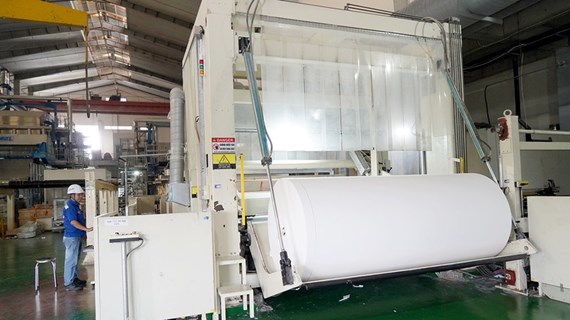Banks on track for 12 percent credit growth target
The State Bank of Vietnam announced recently that banking credit grew by 10.22 percent in the first 11 months.
The State Bank of Vietnam announced recently that banking credit grew by 10.22 percent in the first 11 months.
This means that the full year growth target of 12 percent is certain to be achieved.
Banking industry insiders attribute a rapid increase in credit growth in the last few months to several reasons including the market's increasing seasonal demand for funds and the impacts of the Government's policies to revive the economy.
The early signs of an economic recovery have also made a significant contribution to the growth.
Normally businesses see production activities peak in the fourth quarter to meet the spike in demand during Tet and so their need for funds too goes up.
Of the Government's recent policies, Circular 36 that allows banks to use up to 60 percent of their short-term deposits for medium- and short-term loans and enlarges the categories of borrowers permitted to borrow medium- and long-term loans has also helped accelerate lending.
Another policy to stimulate credit is one from the central bank to lower both the deposit and loan interest rate caps.
As a result of all these, State-owned banks have achieved credit growth of around 10 percent on average while for joint stock banks it is between 15 and 30 percent.
Significantly, the bank loans have been put to good use, flowing as they have into priority sectors listed by the Government.
This is clear from the fact that loans outstanding to small and medium-sized enterprises have increased by 13.8 percent and to the technology sector by 14.8 percent.
Loans to the agricultural and rural development sector have risen by 12.8 percent.
But according to some bank chiefs, many lenders achieved high credit growth mainly through retail lending.
At Sacombank, for instance, which reported credit growth of 15 percent in the first 11 months, retail lending accounts for 50 percent of outstanding loans.
VPBank's credit growth in the first nine months was 34.8 percent, thanks to consumer loans through its financial company FE Credit.
Interestingly, some lenders have reported negative credit growth.
As of the end of September PVcombank had credit growth of minus 6.84 percent, while for ABBank it was minus 1.4 percent and for DongABank it was minus 0.54 percent.
Though this means the bottom line will take a hit, banks remain prudent and very careful about lending to minimise risks.
Controlling bad debts is now more important and difficult than achieving credit growth, they said.-VNA
This means that the full year growth target of 12 percent is certain to be achieved.
Banking industry insiders attribute a rapid increase in credit growth in the last few months to several reasons including the market's increasing seasonal demand for funds and the impacts of the Government's policies to revive the economy.
The early signs of an economic recovery have also made a significant contribution to the growth.
Normally businesses see production activities peak in the fourth quarter to meet the spike in demand during Tet and so their need for funds too goes up.
Of the Government's recent policies, Circular 36 that allows banks to use up to 60 percent of their short-term deposits for medium- and short-term loans and enlarges the categories of borrowers permitted to borrow medium- and long-term loans has also helped accelerate lending.
Another policy to stimulate credit is one from the central bank to lower both the deposit and loan interest rate caps.
As a result of all these, State-owned banks have achieved credit growth of around 10 percent on average while for joint stock banks it is between 15 and 30 percent.
Significantly, the bank loans have been put to good use, flowing as they have into priority sectors listed by the Government.
This is clear from the fact that loans outstanding to small and medium-sized enterprises have increased by 13.8 percent and to the technology sector by 14.8 percent.
Loans to the agricultural and rural development sector have risen by 12.8 percent.
But according to some bank chiefs, many lenders achieved high credit growth mainly through retail lending.
At Sacombank, for instance, which reported credit growth of 15 percent in the first 11 months, retail lending accounts for 50 percent of outstanding loans.
VPBank's credit growth in the first nine months was 34.8 percent, thanks to consumer loans through its financial company FE Credit.
Interestingly, some lenders have reported negative credit growth.
As of the end of September PVcombank had credit growth of minus 6.84 percent, while for ABBank it was minus 1.4 percent and for DongABank it was minus 0.54 percent.
Though this means the bottom line will take a hit, banks remain prudent and very careful about lending to minimise risks.
Controlling bad debts is now more important and difficult than achieving credit growth, they said.-VNA













